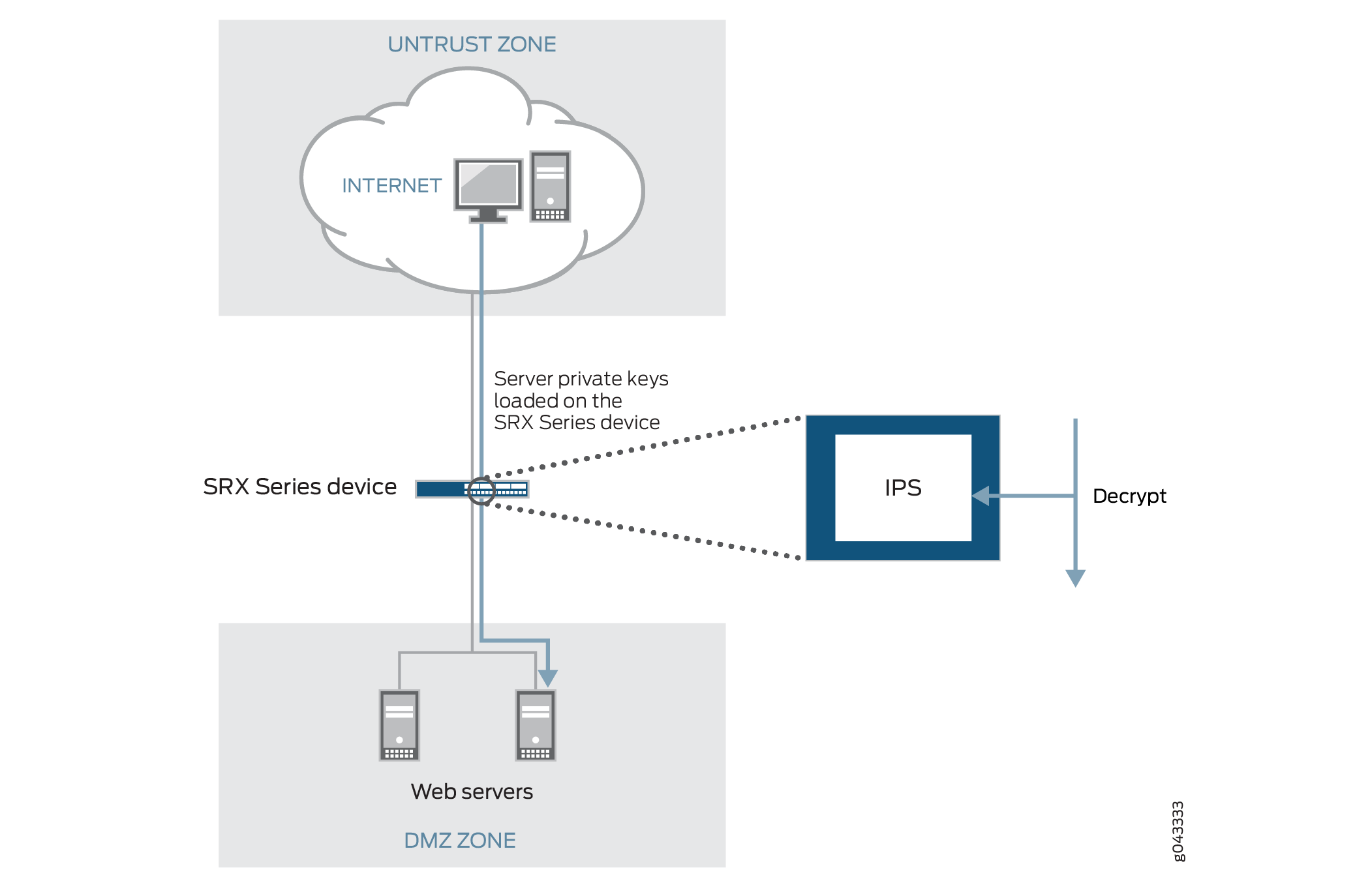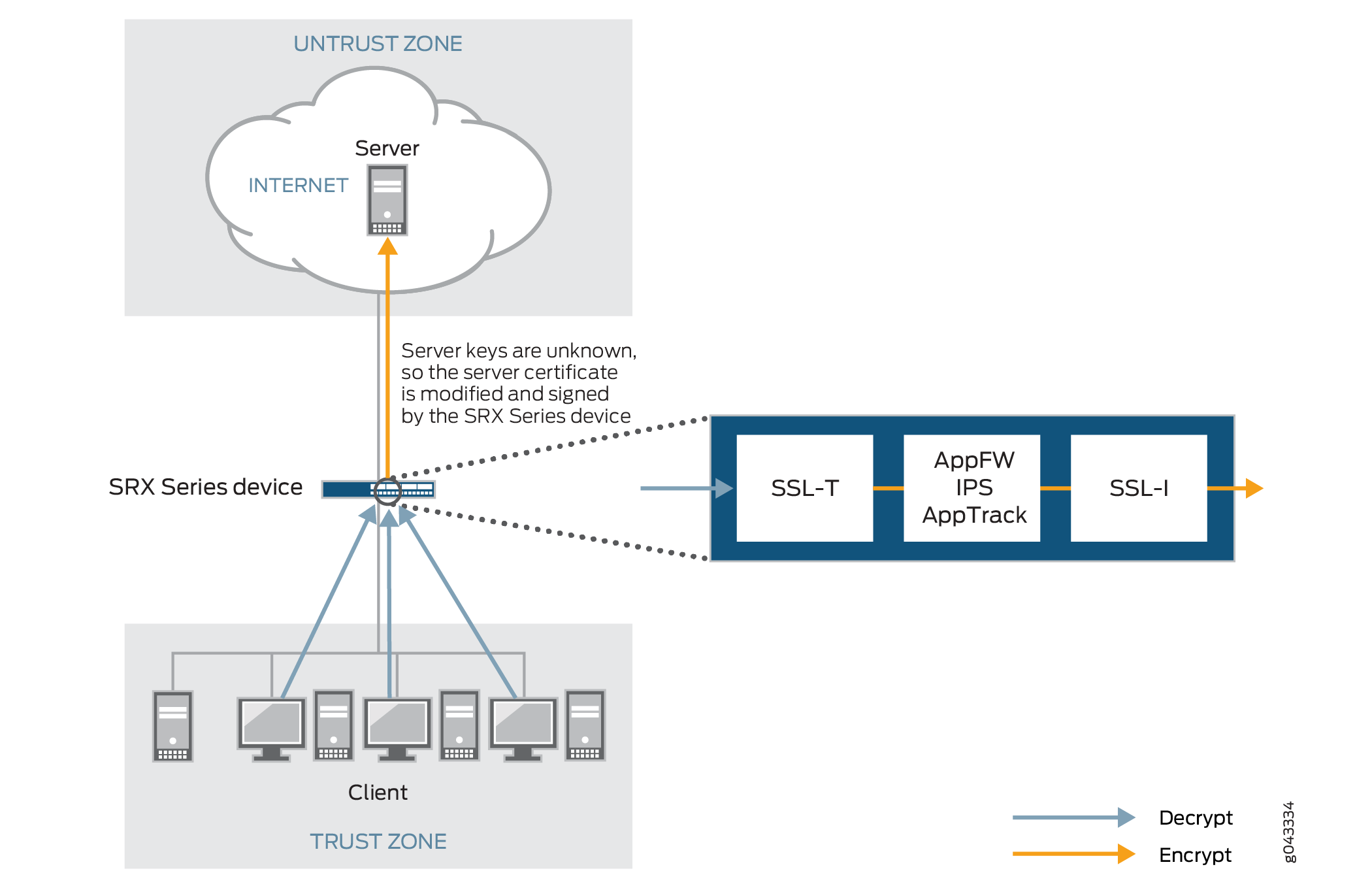SSL Forward Proxy Overview
Secure Sockets Layer (SSL) is an application-level protocol that provides encryption technology for the Internet. SSL, also called Transport Layer Security (TLS), ensures the secure transmission of data between a client and a server through a combination of privacy, authentication, confidentiality, and data integrity. SSL relies on certificates and private-public key exchange pairs for this level of security.
Server authentication guards against fraudulent transmissions by enabling a Web browser to validate the identity of a Web server. Confidentiality mechanisms ensure that communications are private. SSL enforces confidentiality by encrypting data to prevent unauthorized users from eavesdropping on electronic communications. Finally, message integrity ensures that the contents of a communication have not been tampered with.
SSL forward proxy is a transparent proxy; that is, it performs SSL encryption and decryption between the client and the server, but neither the server nor the client can detect its presence. SSL forward proxy ensures that it has the keys to encrypt and decrypt the payload:
For the server, SSL forward proxy acts as a client—Because SSL forward proxy generates the shared pre-primary key, it determines the keys to encrypt and decrypt.
For the client, SSL forward proxy acts as a server—SSL forward proxy first authenticates the original server and replaces the public key in the original server certificate with a key that is known to it. It then generates a new certificate by replacing the original issuer of the certificate with its own identity and signs this new certificate with its own public key (provided as a part of the proxy profile configuration). When the client accepts such a certificate, it sends a shared pre-primary key encrypted with the public key on the certificate. Because SSL forward proxy replaced the original key with its own key, it is able to receive the shared pre-primary key. Decryption and encryption take place in each direction (client and server), and the keys are different for both encryption and decryption.
Figure 1 depicts how SSL inspection (on an existing SRX Series IPS module) is typically used to protect servers. SSL inspection requires access to private keys used by the servers so that the SRX Series device can decrypt the encrypted traffic.

Figure 2 shows how SSL forward proxy works on an encrypted payload. When application firewall (AppFW), intrusion prevention system (IPS), or application tracking (AppTrack) is configured, SSL forward proxy acts as an SSL server terminating the SSL session from the client and a new SSL session is established to the server. The device decrypts and then re-encrypts all SSL forward proxy traffic. SSL forward proxy uses the following services:
SSL-T-SSL terminator on the client side.
SSL-I-SSL initiator on the server side.
Configured AppFW, IPS, or AppTrack services use the decrypted SSL sessions.
If none of the services (AppFW, IPS, or AppTrack) are configured, then SSL forward proxy services are bypassed even if an SSL proxy profile is attached to a firewall policy. IPS does not perform SSL inspection on a session if SSL forward proxy is enabled for that session. That is, if both SSL inspection and SSL forward proxy are enabled on a session, SSL forward proxy always takes precedence.

Supported Ciphers in Proxy Mode
An SSL cipher comprises encryption ciphers, authentication method, and compression. Table 1 displays a list of supported ciphers. NULL ciphers are excluded.
The following SSL protocols are supported:
SSLv3
TLS1
Table 1: Supported Ciphers in Proxy Mode
SSL Cipher | Key Exchange Algorithm | Data Encryption | Message Integrity |
|---|---|---|---|
RSA_WITH_RC4_128_MD5 | RSA key exchange | 128-bit RC4 | Message Digest 5 (MD5) hash |
RSA_WITH_RC4_128_SHA | RSA key exchange | 128-bit RC4 | Secure Hash Algorithm (SHA) hash |
RSA_WITH_DES_CBC_SHA | RSA key exchange | DES CBC | SHA hash |
RSA_WITH_3DES_EDE_CBC_SHA | RSA key exchange | 3DES EDE/CBC | SHA hash |
RSA_WITH_AES_128_CBC_SHA | RSA key exchange | 128-bit AES/CBC | SHA hash |
RSA_WITH_AES_256_CBC_SHA | RSA key exchange | 256-bit AES/CBC | SHA hash |
RSA_EXPORT_WITH_RC4_40_MD5 | RSA-export | 40-bit RC4 | MD5 hash |
RSA_EXPORT_WITH_DES40_CBC_SHA | RSA-export | 40-bit DES/CBC | SHA hash |
RSA_EXPORT1024_WITH_DES_CBC_SHA | RSA 1024 bit export | DES/CBC | SHA hash |
RSA_EXPORT1024_WITH_RC4_56_MD5 | RSA 1024 bit export | 56-bit RC4 | MD5 hash |
RSA_EXPORT1024_WITH_RC4_56_SHA | RSA 1024 bit export | 56-bit RC4 | SHA hash |
RSA-WITH-AES-256-GCM-SHA384 | RSA key exchange | 256-bit AES/GCM | SHA384 hash |
RSA-WITH-AES-256-CBC-SHA256 | RSA key exchange | 256-bit AES/CBC | SHA256 hash |
RSA-WITH-AES-128-GCM-SHA256 | RSA key exchange | 128-bit AES/GCM | SHA256 hash |
RSA-WITH-AES-128-CBC-SHA256 | RSA key exchange | 128-bit AES/CBC | SHA256 hash |
Server Authentication
Implicit trust between the client and the device (because the client accepts the certificate generated by the device) is an important aspect of SSL proxy. It is extremely important that server authentication is not compromised; however, in reality, self-signed certificates and certificates with anomalies are in abundance. Anomalies can include expired certificates, instances of common name not matching a domain name, and so forth.
Server authentication is governed by selecting the Ignore Server Authentication option in the SSL forward proxy profile.
If the Ignore Server Authentication option is not selected, the following scenarios occur:
If authentication succeeds, a new certificate is generated by replacing the keys and changing the issuer name to the issuer name that is configured in the root CA certificate in the proxy profile.
If authentication fails, the connection is dropped.
If the Ignore Server Authentication option is defined as an action in the SSL forward proxy profile, the following scenarios occur:
If the certificate is self-signed, a new certificate is generated by replacing the keys only. The issuer name is not changed. This ensures that the client browser displays a warning that the certificate is not valid.
If the certificate has expired or if the common name does not match the domain name, a new certificate is generated by replacing the keys and changing the issuer name to SSL-PROXY: DUMMY_CERT:GENERATED DUE TO SRVR AUTH FAILURE. This ensures that the client browser displays a warning that the certificate is not valid.
Trusted CA List
SSL forward proxy ensures secure transmission of data between a client and a server. Before establishing a secure connection, SSL forward proxy checks certificate authority (CA) certificates to verify signatures on server certificates. For this reason, a reasonable list of trusted CA certificates is required to effectively authenticate servers.
Ignore Server Authentication
You can use the Ignore Server Authentication option to ignore server authentication completely. In this case, SSL forward proxy ignores errors encountered during the server certificate verification process (such as CA signature verification failure, self-signed certificates, and certificate expiry).
We do not recommend this option for authentication, because configuring it results in websites not being authenticated at all. However, you can use this option to effectively identify the root cause for dropped SSL sessions.
Root CA
In a public key infrastructure (PKI) hierarchy, the root CA is at the top of the trust path. The root CA identifies the server certificate as a trusted certificate.
Session Resumption
An SSL session refers to the set of parameters and encryption keys created by performing a full handshake. A connection is the conversation or active data transfer that occurs within the session. The computational overhead of a complete SSL handshake and generation of primary keys is considerable. In short-lived sessions, the time taken for the SSL handshake can be more than the time for data transfer. To improve throughput and still maintain an appropriate level of security, SSL session resumption provides a session caching mechanism so that session information, such as the pre-primary secret key and agreed-upon ciphers, can be cached for both the client and server. The cached information is identified by a session ID. In subsequent connections both parties agree to use the session ID to retrieve the information rather than create a new pre-primary secret key. Session resumption shortens the handshake process and accelerates SSL transactions.
SSL Proxy Logs
When logging is enabled in an SSL proxy profile, SSL proxy can generate the messages shown in Table 2.
Table 2: SSL Proxy Logs
Log Type | Description |
|---|---|
SSL_PROXY_SSL_SESSION_DROP | Logs generated when a session is dropped by SSL proxy. |
SSL_PROXY_SSL_SESSION_ALLOW | Logs generated when a session is processed by SSL proxy even after encountering some minor errors. |
SSL_PROXY_SESSION_IGNORE | Logs generated if non-SSL sessions are initially mistaken as SSL sessions. |
SSL_PROXY_SESSION_ALLOWLIST | Logs generated when a session is allowlisted. |
SSL_PROXY_ERROR | Logs used for reporting errors. |
SSL_PROXY_WARNING | Logs used for reporting warnings. |
SSL_PROXY_INFO | Logs used for reporting general information. |
All logs contain similar information; the message field contains the reason for the log generation. One of three prefixes shown in Table 3 identifies the source of the message. Other fields are descriptively labeled.
Table 3: SSL Proxy Log Prefixes
Prefix | Description |
|---|---|
system | Logs generated due to errors related to the device or an action taken as part of the SSL proxy profile. Most logs fall into this category. |
openssl error | Logs generated during the handshaking process if an error is detected by the openssl library. |
certificate error | Logs generated during the handshaking process if an error is detected in the certificate (x509 related errors). |
Perfect Forward Secrecy
Perfect Forward Secrecy is a specific key agreement protocol that provides assurance that your session keys are not compromised even if the private key of the server is compromised. By generating a unique session key for every session a user initiates, even if a single session keys gets compromised does not affect any data other than that exchanged in a specific session protected by that particular key.
The Elliptic Curve DHE (ECDHE) cipher suits are supported to enable the perfect forward secrecy on SSL forward proxy. The SSL forward proxy still uses RSA for authentication. However, it uses EC Diffie-Hellman ephemeral key exchange to agree on a shared secret.
ECDHE cipher suites are faster than the DHE counterparts and therefore, the SSL forward proxy supports only ECDHE cipher suits. The ECDHE cipher suits are based on the elliptic curve cryptography which allows you to achieve the same level of security than RSA with smaller keys. For example, a 224 bit elliptic curve is as secure as a 2048 bit RSA key.
Table 4 shows the supported ECDHE cipher suits.
Table 4: Supported ECDHE Cipher Suits
SSL Cipher | Key Exchange Algorithm | Data Encryption | Message Integrity |
|---|---|---|---|
ECDHE-RSA-WITH-AES-256-GCM-SHA384 | ECDHE RSA | 256-bit AES/GCM | SHA 384 hash |
ECDHE-RSA-WITH-AES-256-CBC-SHA384 | ECDHE RSA | 256-bit AES/CBC | SHA 384 hash |
ECDHE-RSA-WITH-AES-256-CBC-SHA | ECDHE RSA | 256-bit AES/CBC | SHA hash |
ECDHE-RSA-WITH-AES-3DES-EDE-CBC-SHA | ECDHE RSA | 3DES AES/EDE/CBC | SHA hash |
ECDHE-RSA-WITH-AES-128-GCM-SHA256 | ECDHE RSA | 128-bit AES/GCM | SHA 256 hash |
ECDHE-RSA-WITH-AES-128-CBC-SHA256 | ECDHE RSA | 128-bit AES/CBC | SHA 256 hash |
ECDHE-RSA-WITH-AES-128-CBC-SHA | ECDHE RSA | 128-bit AES/CBC | SHA hash |
